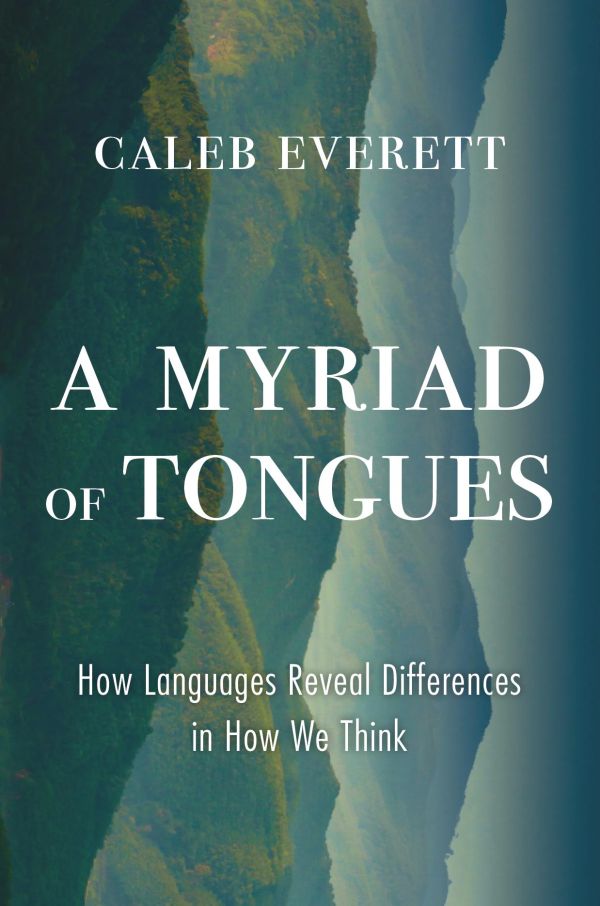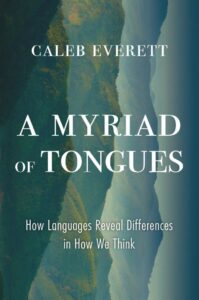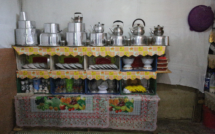

I once interviewed a candidate for a junior academic position whose disciplinary training was very different from my own. When I challenged him on a certain point, he exclaimed—with a spontaneous delight that endeared him to me on the spot—“Oh! How fascinating! That is completely different from the way I’m used to thinking!” I was reminded of his response while reading Caleb Everett’s A Myriad of Tongues: How Languages Reveal Differences in How We Think. Above all, Everett’s aim is to induce in the reader a similar Copernican moment, in which encountering the world’s lesser-known languages reveals radically unfamiliar modes of expressing human experiences—even those that may seem elemental and universal, involving concepts such as color, smell, familial relationships, space, and time. It would take a rather incurious reader not to experience the kind of mind-expanding delight expressed by my colleague.
For example, it may seem self-evident that the human concept of time is divided into past, present, and future. It stands to reason that our linguistic categories would reflect this division. However, languages exhibit tremendous variety in the way they categorize time. Karitiâna, spoken in southern Amazonia, makes no linguistic distinction between past and present events, but encodes these differently than future events. In contrast, Yagua, another Amazonian language, recruits eight tenses, two of which differentiate events in the near future from those in the distant future and five of which are devoted to slicing the past into even more fine-grained categories.
Moreover, while many languages (but not all!) recruit physical space as a template for talking about time, they do so in variously inventive ways. We talk about past events as behind us and future events as ahead of us, but a speaker of Aymara might be flummoxed by this—clearly, the past lies ahead and the future behind, as you can “see” the past with greater clarity than the hidden future that is waiting to sneak up on you. The Yupno, who live in the highlands of New Guinea, have devised an entirely different metaphor for time; an event that occurred a few years ago would be described as “a few years down the hill” while an event likely to occur in a month would be “a month up the hill.”
The book, intended for the non-specialist reader, offers a beguiling tour of the variation in vocabularies for other core human concepts, as well as in languages’ inventories of sounds and their syntactic possibilities. As Everett notes, the great majority of work in contemporary linguistics has taken place in so-called WEIRD (Western, educated, industrialized, rich, and democratic) communities, with an almost blinkered focus on Indo-European languages. This limited perspective has nurtured theories that orbit around a group of closely related languages; within its confines, linguists have neglected the true scope of linguistic diversity and made overly ambitious claims about universal properties of language that are presumed to stem from a shared human biology and cognition. Everett’s own career as an anthropological linguist—indeed, his whole life, beginning with his childhood as the son of Amazonian missionaries—has put him in close contact with languages and societies very different from those inhabited by most readers of his book. And it is precisely within such societies that the imprint of culture upon language becomes readily visible to us. An important theme of the book is the complex nature of this interplay, with language responding to the communicative pressures and opportunities found in various physical and cultural environments.
In some cases, the link between a language and its physical/cultural environment is readily apparent, as it is for Nheengatú, a language spoken in the equatorial region of Brazil. No temporal phrases are available to indicate the time of day that an event occurred or will occur; instead, the speaker conveys this meaning by pointing to the sun’s position in the sky at that time. To assert, “I’ll be back at noon,” for example, the speaker would point directly overhead while uttering the equivalent of “I’ll be back.” Clearly, such a linguistic device is only possible within a culture that is intimately bound to the outdoors and in an equatorial location where the sun’s position is stable.
In other languages, industrialization has left its mark, prompting the development of abstract color vocabularies. Not all languages, it turns out, have a word to indicate the color blue or yellow. In non-industrialized societies, color is rarely dissociable from the things one talks about, so a person might refer to a yellow object as “banana-colored.” Odd as this may seem to us, a speaker of Maniq, a language spoken in the jungles of Thailand, might be puzzled by the fact that English has virtually no abstract words for odors (other than perhaps “musty” and “acrid”). Confronted with a certain scent, we might describe it as “like popcorn.” In Maniq, however, speakers have at least fifteen commonly used odor terms at their disposal, and a single word captures what is common to the scent of tubers, rice, cooked wild pig, and animal hair. Comparisons of horticultural and hunter-gatherer groups in the same geographic region hint at the possibility that the lifestyle of the latter is especially conducive to a rich olfactory vocabulary.
At times, the connection between language and environment is far more subtle. Everett assembles evidence for the claim that agricultural societies are more likely than hunter-gatherer groups to contain the labiodental sounds “f” and “v” in their languages. These sounds are made by touching the lower lip to the upper teeth and are easier to make for individuals with an overbite. A slight overbite, common in many contemporary societies, appears to be linked to the introduction of soft foods such as rice and bread, and to the availability of utensils that shred food into small pieces. It is less common among hunter-gatherer peoples, who rely more on their teeth to grind and cut the food they eat. Some of Everett’s own research finds that not only are labiodental sounds unusually rare among hunter-gatherer groups, but they are also less likely to be produced in languages that contain these sounds by individuals whose teeth are aligned edge to edge; among English speakers with no overbite, “f” was pronounced as closer to “p,” made by closing the lips together, a finding that supports the causal link between diet and a language’s phonetic inventory.
Everett makes no claims to be a pioneer in this field. One of the striking aspects of the book is its modest (at times even reticent) tone and its emphasis on the incremental and collaborative nature of research. There is no flamboyant prose and no grandstanding here, noteworthy in an area of linguistics that has seen its share of sweeping claims and clashes of titans. (The author happens to be the son of the controversial anthropologist Daniel Everett, who was portrayed as Noam Chomsky’s nemesis in Tom Wolfe’s massively entertaining but scientifically vapid book, The Kingdom of Speech.) Here, the author sees his role less as a trailblazer and more as a conscientious guide to the current state of knowledge regarding the world’s languages and the modes of thought attached to them. He includes his own research contributions but chooses not to foreground them. He advocates for an expansive view of linguistic research, one that involves meaningful crosstalk with disciplines as diverse as cognitive psychology, data science, archaeology, political science, and physiology. It is this communal orientation, he argues, that exemplifies the cutting edge of linguistic research.
Much is unknown about why certain languages adopt the linguistic devices they do and how this molds cognition, if it does. Everett acknowledges these gaps, resisting overreach in his conclusions. The book is marbled with statements such as “Much debate persists around this claim,” or “It is difficult to establish a causal link.” Despite these limits, the cumulative examples the author brings to the reader’s attention succeed in making the case that “every time a linguist describes a language whose properties were unknown beforehand, our understanding of language and thought shifts a little bit. Sometimes a lot.”
Everett’s reluctance to draw unsupported conclusions is certainly welcome, but at times he seems almost averse to controversy, or unwilling to venture an opinion or speculation, or even to delve more deeply into the implications of certain ideas. He often sidesteps the specifics of exactly how certain linguistic properties might shift our understanding of language and thought. The reader may be left with the sense that the author is withholding his own thoughts on the matter. For example, in an exposition on grammatical gender, Everett chooses not to engage with the question of why gender is such a salient aspect of the grammar of some languages while being entirely absent from others. What, if anything, are we to make of the fact that Finnish and Farsi speakers, while representing very different cultural attitudes toward gender, both make use of a gender-neutral pronoun? Admittedly, there is precious little empirical research to settle such questions, but given the cultural salience of the topic, readers would benefit even from a responsible discussion of what we currently do not know about language and gender, or what kind of evidence could in principle address some of the current debates.
Similarly, Everett devotes a few pages to syntactic recursion, the topic that embroiled his father in a high-stakes debate and landed him in the pages of Tom Wolfe’s book. Much has been made of Daniel Everett’s claim that the Pirahã language does not stack clauses. For example, instead of embedding a relative clause within a main clause in a sentence such as “Sergio kicked the boy who ran,” a Pirahã speaker would concatenate clauses like this: “Sergio kicked the boy. He ran.” Given that Chomskyan theories of linguistics accord a prominent role to such recursive structures, this claim has met with much resistance. In these scant pages, the author’s contribution is merely to point out that other linguists before his father have noted the lack of recursion in various languages and that the structure is, in fact, relatively infrequent in spoken language, even in a language like English. He mildly notes that lack of recursion is yet another example of a linguistic phenomenon that only seems unusual because of the field’s over-reliance on Indo-European languages. But the throwaway remark about spoken English masks a rich line of inquiry that remains unexplored in the book. Some linguists have proposed that recursion may have developed in tandem with literacy; relative clauses are rare in the early written records of several languages and appear to gain steam as a written culture becomes entrenched. Though somewhat speculative, this hypothesis hints at profound implications of literacy on language, and it seems a missed opportunity not to have given readers a taste of it.
I am loath to complain about an author hewing too close to the data. But in his reticence to offer more interpretation, Everett risks understating the urgency of the research for which he advocates. He relies somewhat too heavily on the reader, who may be unequipped, to infer the full range of implications of the dazzling diversity he has gathered for us. Everett rightly notes that languages—especially non-WEIRD languages spoken by only a few people—are entering a period of mass extinction just as serious typological research is ascendant. Linguistics has benefited from the many living Indo-European languages; for example, it is thanks to tongues as diverse as Armenian, Albanian, Polish, and Punjabi that we can reconstruct what their common ancestor, Proto-Indo-European, might have looked like. Nascent as it is, cross-cultural typological research may one day offer glimpses of not just how a long-ago people spoke, but also something about how they lived and how they conceptualized the world. That is, unless too many languages vanish before we can ever hope to draw such conclusions with any confidence.
Julie Sedivy is the author of Memory Speaks: On Losing and Reclaiming Language and Self. Her most recent book, Linguaphile: A Life of Language Love, will be published in 2024 by Farrar, Straus and Giroux.
A Myriad of Tongues: How Languages Reveal Differences in How We Think
By Caleb Everett
Publisher: Harvard University Press
Hardcover / 288 pages / 2023
ISBN: 9780674976580
Published on April 15, 2024.




